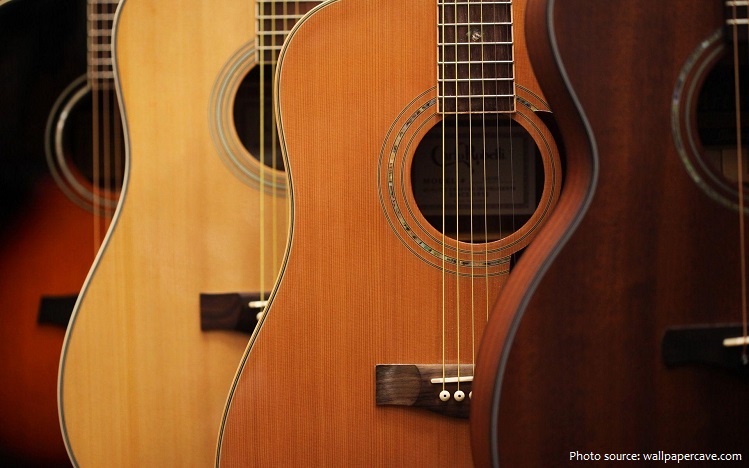
The guitar is a musical instrument.
Guitars can be divided into two broad categories, acoustic and electric guitars.
It is used in a wide variety of musical styles, as acoustic and electric models, in both classical and contemporary forms.
The guitar is most recognized in popular culture as the primary instrument in blues, country, reggae, flamenco, pop and rock musical genres.
The standard guitar has six strings, but four-, seven-, eight-, nine-, ten-, eleven-, twelve-, thirteen- and eighteen-string guitars are also available.
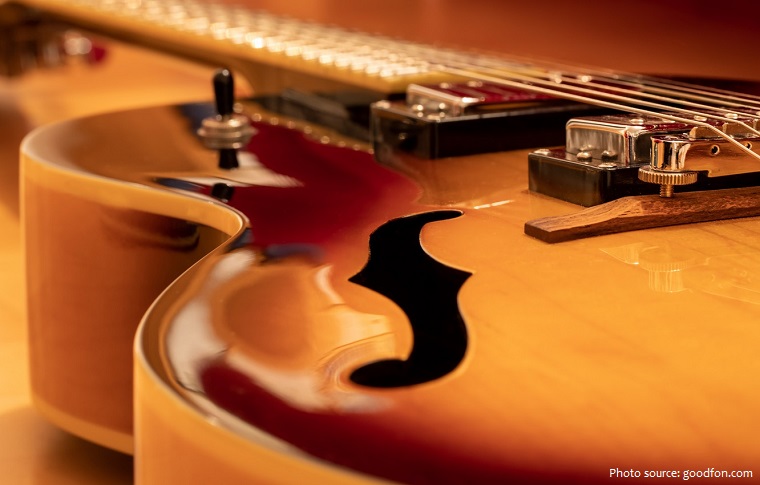
It is typically played with both hands by strumming or plucking the strings with either a guitar pick or the fingers/fingernails of one hand, while simultaneously fretting (pressing the strings against the frets) with the fingers of the other hand.
The sound of the vibrating strings is projected either acoustically, by means of the hollow chamber of the guitar (for an acoustic guitar), or through an electrical amplifier and a speaker.
The guitar is an ancient and noble instrument, whose history can be traced back over 4000 years.
The history of the guitar generally goes back to two instruments, the oud and the lute, which predate written history.
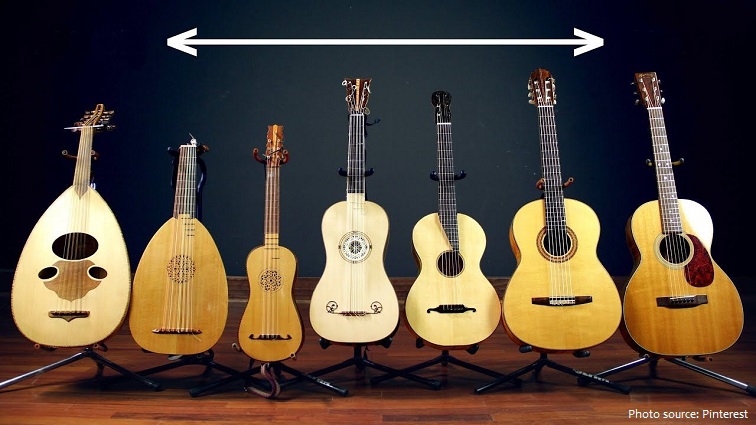
Many say that a man known as Lamech, who was Noah’s grandfather and the sixth grandson of Adam and Eve, designed the Arab precursor to the guitar. Lamech was apparently inspired to design the shape of the instrument, known as an oud, after hanging the body of his dead son from a tree.
The Moors brought the oud with them when they invaded Southern Spain in 711 AD.
At least two instruments called “guitars” were in use in Spain by 13th century – the guitarra latina (Latin guitar) and the so-called guitarra morisca (Moorish guitar). By the 14th century the qualifiers “moresca” or “morisca” and “latina” had been dropped, and these two chordophones were simply referred to as guitars.
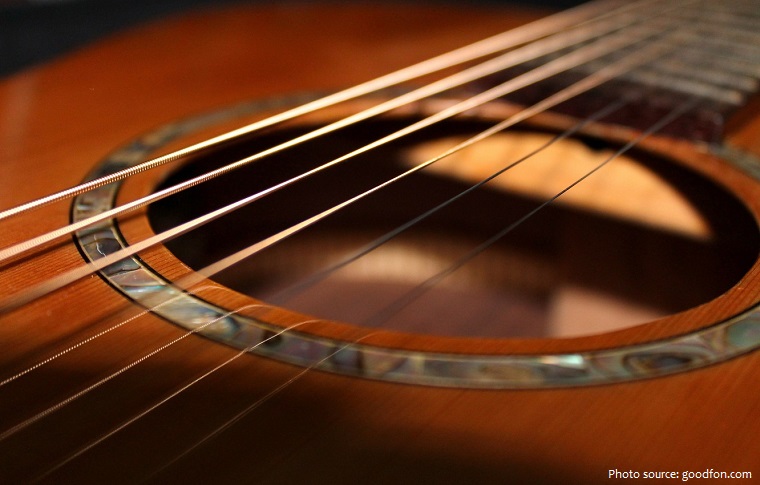
By the 16th century, most of the forms of guitar had fallen off, to never be seen again. However, midway through the 16th century, the five-course guitar was established. It was not a straightforward process.
By the 1790’s, Spanish guitars had been standardized as to type and had six courses of strings, much resembling a modern guitar. This is where guitar history really gets going, and the innovations start to speed up, eventually leading to the instruments we know and love today.
Finally, circa 1850, the form and structure of the modern guitar is followed by different Spanish makers such as Manuel de Soto y Solares and perhaps the most important of all guitar makers Antonio Torres Jurado, who increased the size of the guitar body, altered its proportions, and invented the breakthrough fan-braced pattern. Bracing, which refers to the internal pattern of wood reinforcements used to secure the guitar’s top and back and prevent the instrument from collapsing under tension, is an important factor in how the guitar sounds. Torres’ design greatly improved the volume, tone, and projection of the instrument, and it has remained essentially unchanged since.
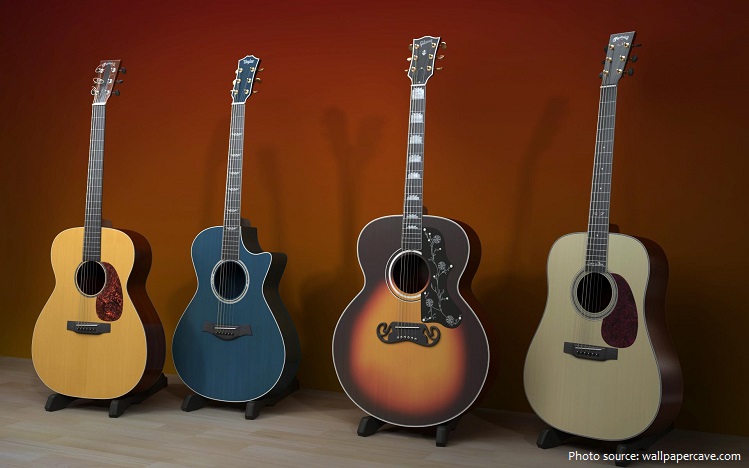
Electric guitars, introduced in the 1930s, use an amplifier and a loudspeaker that both makes the sound of the instrument loud enough for the performers and audience to hear, and, given that it produces an electric signal when played, that can electronically manipulate and shape the tone using an equalizer and a wide variety of electronic effects units, the most commonly used ones being distortion and reverb.
There are three main types of modern acoustic guitar: the classical guitar, the steel-string acoustic guitar and the archtop guitar, which is sometimes called a “jazz guitar”.
Guitar music from the 16th to 18th century was notated either in tablature (showing the position of the fingers on the frets and the strings to be plucked) or in a system of alphabetical chord symbols. Jazz-guitar tablature shows chord symbols on a grid representing strings and frets.

The most expensive guitar sold at auction is Kurt Cobain’s ‘MTV Unplugged’ guitar, and was purchased by Peter Freedman (Australia) for $6,010,000 (£4,815,430; €5,352,000) at Julien’s auctions in Los Angeles, California, USA on 19 June 2020.
The most valuable guitar is $2,000,000 and was created by Aaron Shum (Hong Kong). The value was certified in Hong Kong, China, on 15 March 2015. The guitar is called ‘Eden of Coronet’ and is adorned with 11,441 pieces of diamond (401.15 carats) and 18k white gold (1.635 kg / 57.67 oz). It
was formally unveiled at the Swiss Baselworld exibition.
The most jewels on a guitar is 16,033 and was achieved by Aaron Shum Jewelry Ltd. (Hong Kong) in Basel, Switzerland, as verified on 11 March 2016. The Fender guitar was decorated with a range of stones including topaz, citrine, rhodolite and cubic zirconium.
The largest playable acoustic guitar is one measuring 16.75 m (59 ft 11 in) long, 7.57 m (24 ft 10 in) wide and 2.67 m (8 ft 9 in) deep. The instrument was built by Realizarevents, Porto, Portugal, and weighs four tons (8,818 lb).
The largest playable electric guitar in the world is 13.29 m (43 ft 7.5 in) tall, 5.01 m. (16 ft 5.5 in) wide and weighs 907 kg (2,000 lb). Modelled on a 1967 Gibson Flying V and built to a scale of 1:12, it was made by students from Conroe Independent School District Academy of Science and
Technology, Conroe, Texas, USA at a cost of US$3,000 (£1,975). With construction beginning in October 1999, the instrument was finally played at the Cynthia Woods Mitchell Pavilion on 6 June 2000 with the opening chord of ‘A Hard Day’s Night’.
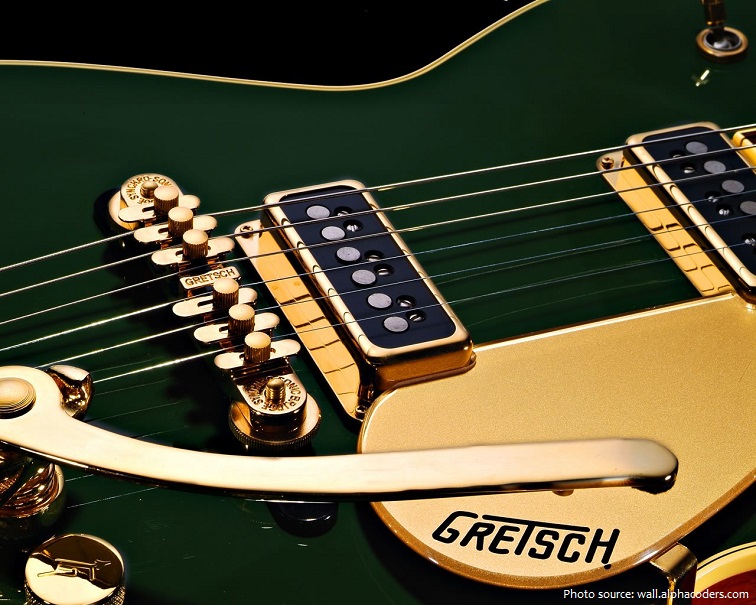
Smallest replica guitar is a guitar carved from a block of silicon and based on a Fender Stratocaster, measured ten micrometres long – 1/20 the thickness of human hair. Made in 1997 in just twenty minutes by scientists at the Cornell University, New York, USA, each of its six strings were 0.05 micrometres thick, equivalent to 100 atoms laid end to end.
The longest marathon playing guitar by an individual is 114 hours 6 minutes 30 seconds and was achieved by David Browne (Ireland) at the Temple Bar Pub, Dublin, Ireland, from 12 to 17 June 2011.
The longest guitar lesson is 24 hr 6 min and was achieved by Thomas Binns (UK) in London, UK, from 18 to 19 July 2019.
The largest guitar ensemble was achieved by 6,346 participants in an event organised by Thanks Jimi Festival, in Wroclaw, Rynek, Poland, on 01 May 2009.
